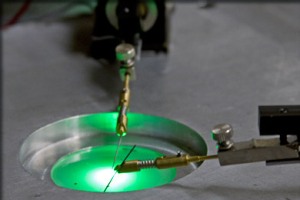A research team at the Rensselaer Polytechnic Institute has discovered a novel technique to enhance the light output of green-colored LEDs. The method also improves internal efficiency and light extraction.
The new technique involves etching a nanoscale pattern at the intersecting area of the gallium nitride layer and the sapphire base of the LED. Sapphire is a low-cost substrate material and widely used in LED production.
 Green-colored LEDs
Green-colored LEDs
Inexpensive and powerful LEDs of red and blue color exist, but green LED is yet to be developed. Televisions, monitors and similar devices use blue, green and red colors. The development of a green LED would lead to new energy-efficient and high-performance illumination and display devices.
LEDs are basically semiconductors that can change electricity into light. They are durable and produce minimal amount of heat. They consume low amount of energy when compared to conventional light bulbs. LED lights do not contain any toxic heavy metals that are generally used in compact fluorescent bulbs.
Green-colored LEDs could be used to produce a variety of colors, including true white. Existing white LEDs are in fact blue LEDs, which are coated with yellow phosphorus, to produce a blue tinge.